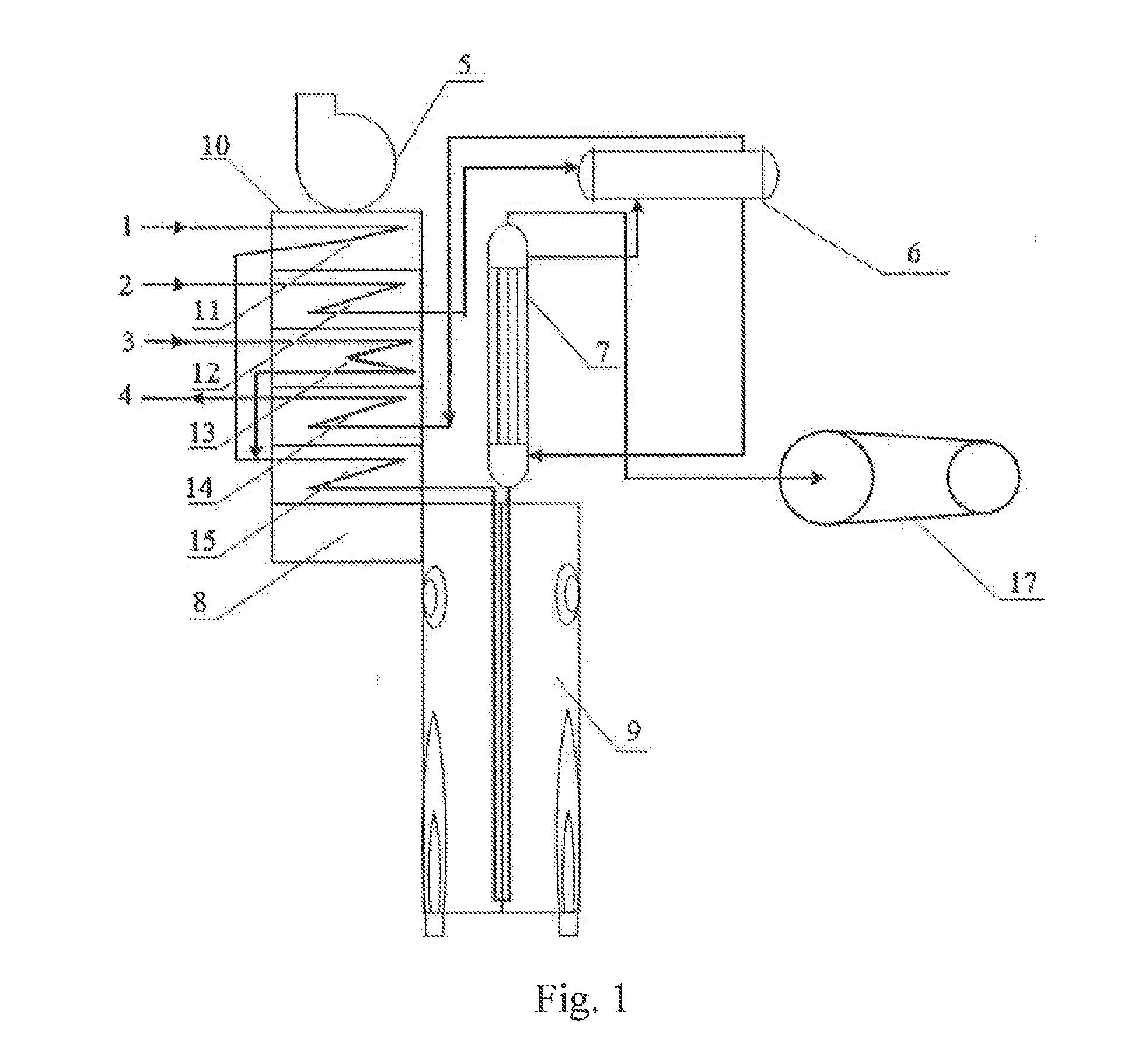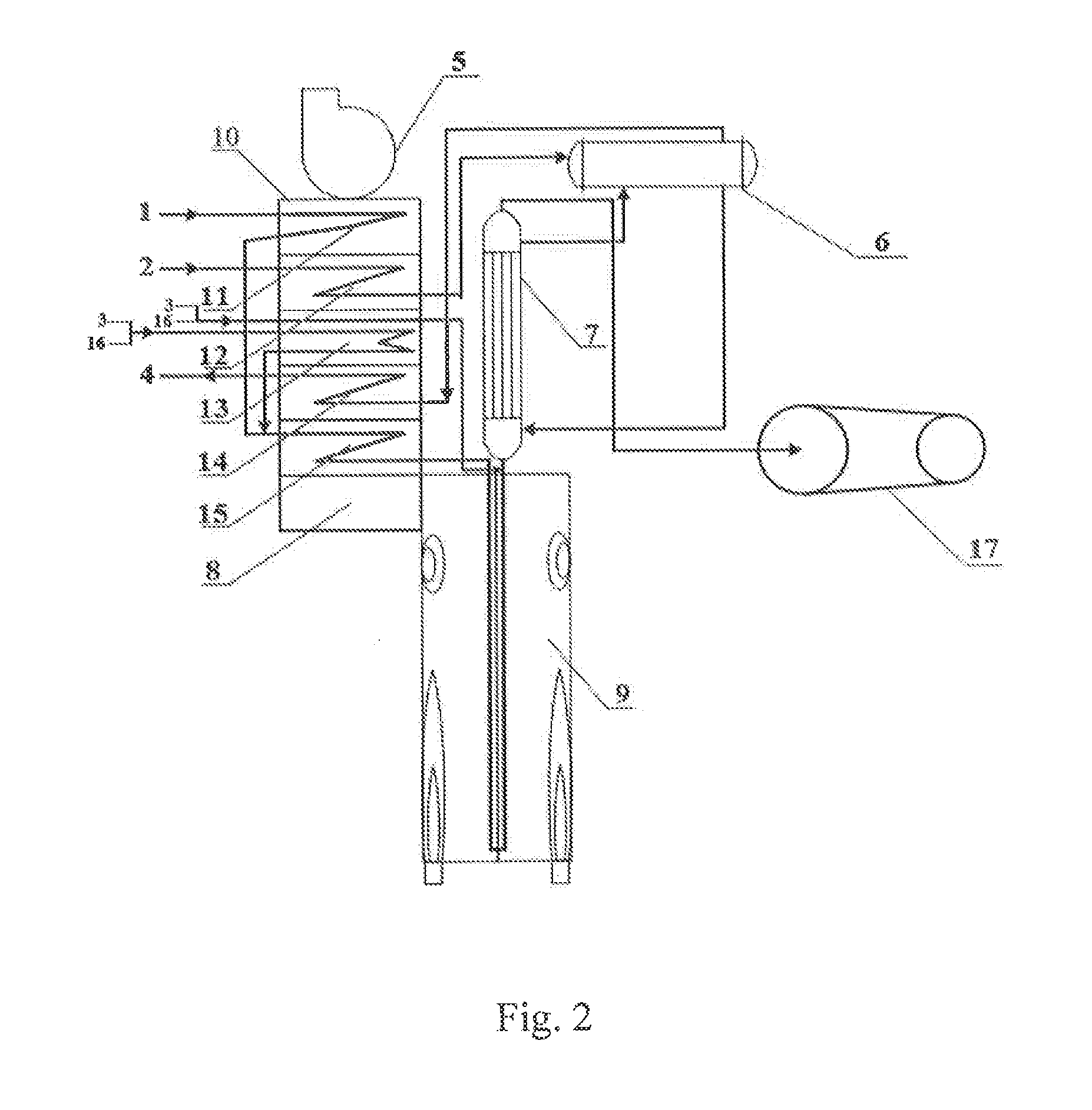Steam cracking processes
a technology of steam cracking and process, applied in the direction of thermal non-catalytic cracking, pressure chemical process, organic chemistry, etc., can solve the problems of heavy liquid phase hydrocarbon components, serious impact on heat transfer process, and easy formation of cok
- Summary
- Abstract
- Description
- Claims
- Application Information
AI Technical Summary
Benefits of technology
Problems solved by technology
Method used
Image
Examples
example 1
[0111]This example is used to explain the steam cracking process provided in the present disclosure,
[0112]The cracking apparatus as shown in FIG. 2 is adopted for the cracking reaction. The specific process comprises:
[0113]Naphtha 1 of 60° C. (see Table 1 for the corresponding parameters) is preheated in the material preheating segment 11, and simultaneously a first stream composed of steam 3 and a monoolefin-containing (mixed C4 olefins) stream 16 with the composition as shown in Table 2 is preheated in the diluted steam superheating segment 13. After that, the preheated naphtha and the preheated first stream are mixed and the resulting feed stock mixture is heated in the hybrid heating segment 15 before entering into the radiant section 9 for cracking reaction. In addition, a second stream composed of steam 3 and mixed C4 olefins 16 with the composition as shown in Table 2 is preheated in the diluted steam superheating segment 13 to obtain a first mixture (the monoolefin-containin...
example 2
[0119]The process of Example 1 (see FIG. 2) is adopted to carry out the steam cracking reaction. But the feeding rate of naphtha is 40,860 kg / h, and in the first stream the injection rate of steam is 22,700 kg / h and the feeding rate of the mixed C4 olefins is 4,540 kg / h. In the second stream, the injection rate of steam is 2,270 kg / h and the feeding rate of the mixed C4 olefins is 1,362 kg / h. The temperatures of the preheated first and second streams are respectively 530° C. and 560° C. The crossover temperature (XOT) is 596° C. and the temperature at the outlet of the cracking furnace (COT) is 830° C. The cracking reaction time in the radiant section 9 is 0.3 s. Other process parameters of the cracking furnace and transfer line exchange 7 are listed in Table 7. The cracked gases are separated and analyzed and the composition thereof is shown as in Table 8.
TABLE 7TemperaturePressureFlow (kg / h)(° C.)(kPa-g)Feed stockInitial stage toInitialFinalInitialFinalOperational stagefinal stage...
example 3
[0120]The cracking furnace as shown in FIG. 3 is adopted for the cracking reaction. The specific process comprises:
[0121]The C4 olefins 16 with the composition as shown in Table 2 are added into the evaporator for vaporization and mixed C4 olefins of 180° C. are obtained. The mixed C4 olefins are then mixed with hydrogen 18 and steam 3 to obtain a first mixture, which is divided into a first stream and a second stream for the cracking reaction of the present disclosure.
[0122]Naphtha 1 of 60° C. (see Table 1 for the corresponding parameters) is preheated in the material preheating segment 11, and steam 3 is simultaneously preheated in the diluted steam superheating segment 13. The preheated naphtha and the preheated steam are mixed and the resulting feed stock mixture is preheated to the crossover temperature in the hybrid heating segment 15 before being mixed with the first stream of the first mixture. The mixed resultant is then injected into the radiant section 9 for cracking reac...
PUM
| Property | Measurement | Unit |
|---|---|---|
| temperature | aaaaa | aaaaa |
| temperature | aaaaa | aaaaa |
| temperature | aaaaa | aaaaa |
Abstract
Description
Claims
Application Information
 Login to View More
Login to View More - R&D
- Intellectual Property
- Life Sciences
- Materials
- Tech Scout
- Unparalleled Data Quality
- Higher Quality Content
- 60% Fewer Hallucinations
Browse by: Latest US Patents, China's latest patents, Technical Efficacy Thesaurus, Application Domain, Technology Topic, Popular Technical Reports.
© 2025 PatSnap. All rights reserved.Legal|Privacy policy|Modern Slavery Act Transparency Statement|Sitemap|About US| Contact US: help@patsnap.com



